Football, also called American football, is an exciting team sport played chiefly in the United States and Canada. The term football is also used for team sports played in other parts of the world. For example, the game called soccer in the United States is called association football, or simply football, in most other countries. A game resembling American football, called rugby, is also played in many countries as either rugby union or rugby league. Other types of football include Gaelic football, played in Ireland, and Australian rules football, played in Australia. This article discusses American football. For information on other sports called football, see Soccer and Rugby football.
American football is played by elementary school, high school, college, and professional teams. Millions of people crowd stadiums each football season to watch their favorite teams. Millions of people also watch games on television between college football teams. They also watch televised competition in the two major professional leagues, the National Football League (NFL) of the United States and the Canadian Football League (CFL).
In the United States, football is played by two teams of 11 players each. Canadian teams have 12 players. Each team tries to score points, mainly by running or passing plays that move an oval ball across the opposing team’s goal line. Such a run or pass scores a touchdown. During a game, possession of the ball shifts from team to team. The team with the ball is the offensive team or offense. The other team is the defensive team or defense. It tries to prevent the offense from scoring.
A good football team combines strength and speed. Physical contact, especially involving blocking and tackling, is a basic part of football. The sport also requires quick reactions and thorough preparation for each game. In addition, split-second teamwork is essential.
There are several variations of football. Two variations—touch football and flag football—eliminate much of the physical contact. In touch football, a play ends when a defensive player merely touches, rather than tackles, the ball carrier. In flag football, a play ends when a defender pulls a piece of cloth, called a flag, from the belt or back pocket of the ball carrier.
Touch and flag football are popular in high school and college intramural programs. In such programs, teams from the same school compete against one another. Some high schools with small enrollments have football teams with six, eight, or nine players. A few professional women’s football teams have formed leagues, and a few high schools have teams for girls. The game is played almost entirely by men and boys, however, and this article concerns male football only.
This article deals chiefly with football in the United States. The game differs slightly in Canada. The section Canadian football describes some of the differences.
The field and equipment
The field.
Most distances in football are measured in yards. One yard equals 0.91 meter. Football is played on a level area 120 yards long and 531/3 yards wide. The field may have a surface of natural grass or of a synthetic material. All indoor stadiums and many outdoor stadiums use green synthetic surfaces that look like grass. 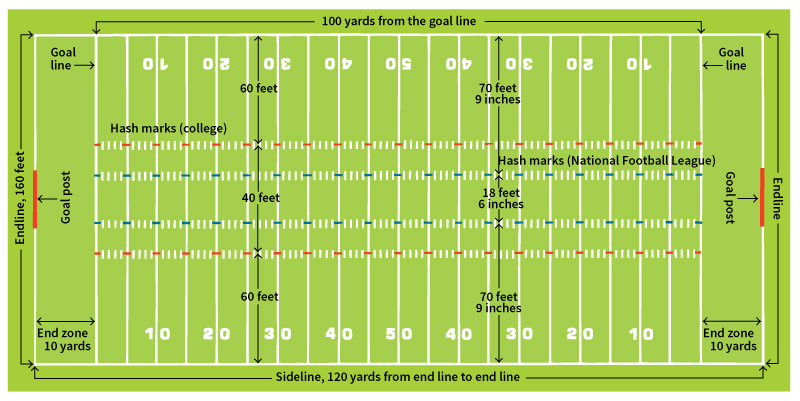
The football field is marked with white lines. It is often called a gridiron because the pattern of lines resembles the cooking utensil used to broil foods. A sideline borders each of the two long sides of the field. Any player who touches or crosses a sideline is out of bounds.Yard lines cross the field every 5 yards. Near each end of the field is a goal line. The goal lines are 100 yards apart. An area called an end zone extends 10 yards beyond each goal line. The yard lines are numbered from each goal line to the 50-yard line, also called midfield. 
Two rows of lines, called hash marks, parallel the sidelines. All plays start with the ball between or on the hash marks. If a play ends out of bounds or between the hash marks and the sideline, the ball is placed on the nearest hash mark for the next play.
In high school and college football, two goal posts stand on the end line 10 yards behind each goal line. A crossbar connects the posts 10 feet (3 meters) above the ground. In the NFL, a single post 6 feet (1.8 meters) behind the end line curves forward and supports the crossbar directly over the end line. In high school games, the goal posts are each 20 feet (6 meters) high and 23 feet 4 inches (7 meters) apart. In college and NFL football games, the goal posts are each 30 feet (9 meters) high and 18 feet 6 inches (5.6 meters) apart.
The ball
is oval. It is about 11 inches (28 centimeters) long. It is about 7 inches (18 centimeters) in diameter at the center. Balls used in high school, college, and professional games are made of four pieces of leather stitched together. Footballs used in recreation may be made of rubber or plastic. A football has a rubber lining, which is inflated to an air pressure of 121/2 to 131/2 pounds per square inch (0.88 to 0.95 kilogram per square centimeter). The ball weighs 14 to 15 ounces (397 to 425 grams). Leather laces along one seam provide a grip for holding and passing the ball.
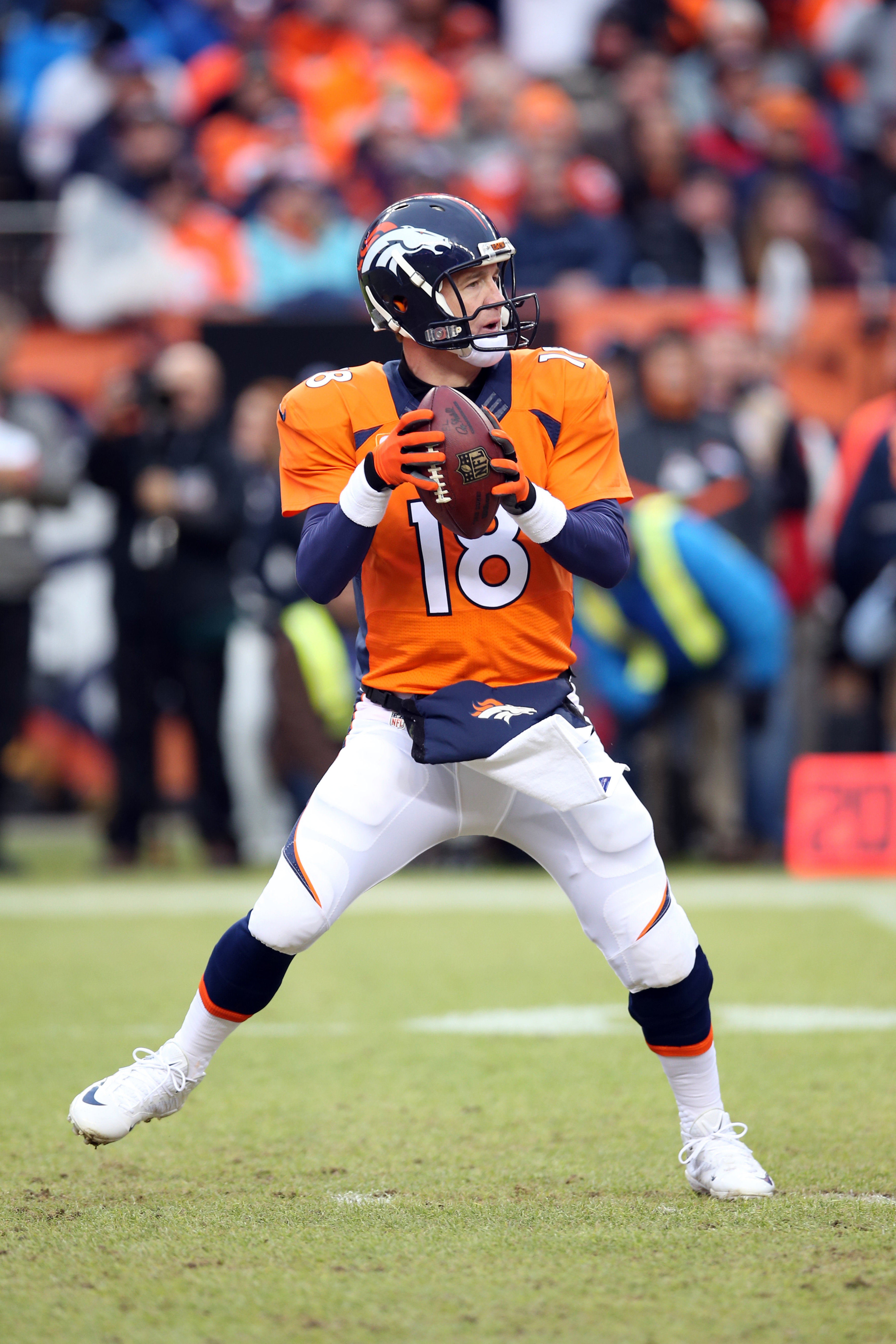
The uniform.
A football player’s uniform is made of cotton or nylon and consists of a shirt and pants. The shirt is called a jersey. It has the player’s number—and sometimes his name—sewn on the back and front for identification by the officials and spectators. The uniforms fit tightly so that opposing players cannot easily grasp them when trying to block or tackle.
Protective equipment
helps prevent injuries. The amount of equipment a player wears depends on his position. The section called The players and coaches describes the duties of the various players. Linemen wear more protective equipment than other players because they are involved in the most physical contact through blocking and tackling. Backs and ends wear less equipment so that they can run at top speed. 
Each player wears a helmet held in place with a chin guard. The helmet has a face mask. Most players also wear a mouthpiece to help prevent injuries to their teeth. Under their uniforms, the players wear shoulder, hip, thigh, and knee pads. In many cases, the thigh pads and knee pads are sewn into the pants. Some players also use arm guards, elbow pads, rib pads, and liners to protect the shins.
Football players wear shoes that help prevent slipping and provide good traction for running. When the game is played on grass, players wear shoes with cleats. On synthetic surfaces, they wear shoes with specially designed soles for better traction. Some players wear high-top shoes that lace up to their ankles. The lacing gives the ankles more support and helps prevent sprains. Most backs and ends prefer low-cut shoes that enable them to make quick cuts (changes in direction).
The players and coaches
Most football teams have players who specialize in offense and others who play defense. Before each play, the offense from one team and the opponents’ defense face each other along the line of scrimmage. This imaginary line aligns with the spot where the preceding play ended. The line of scrimmage parallels the yard lines and passes through the tip of the ball nearest each team’s goal. Thus, each team has its own line of scrimmage, separated by the length of the football. The area between the two lines is called the neutral zone.
The offensive team
consists of seven players called linemen and four called backs. The team must have at least seven players on the line of scrimmage when the play begins. The five linemen in the middle are known as interior linemen. They are the center, two guards, and two tackles. The center snaps (tosses or hands) the ball between his legs to a back to begin a play. All five interior linemen block for the ball carriers, the passers, and the pass receivers.

The two linemen farthest from the center on either side are ends. In addition to blocking, they are eligible to catch passes. In most offensive strategies, the end called the tight end is used more as a blocker than a pass receiver. He lines up close to the tackle to be in a better position to block. The other end is the more important pass receiver. He usually splits away from the other linemen. This improves his opportunity to run down-field to catch passes. He is normally called a wide receiver, though the older term split end is sometimes used.
The four backs make up the backfield. The team’s arrangements of players, called offensive formations or simply offenses, receive their names from the various positions of the backs. For example, in the T-formation, the quarterback receives the snap close to the center. The fullback lines up 5 yards directly behind the quarterback, and two halfbacks line up on either side of the fullback. A line drawn from the quarterback to the fullback makes the stem of a T. A line from one halfback to the other is the top bar.
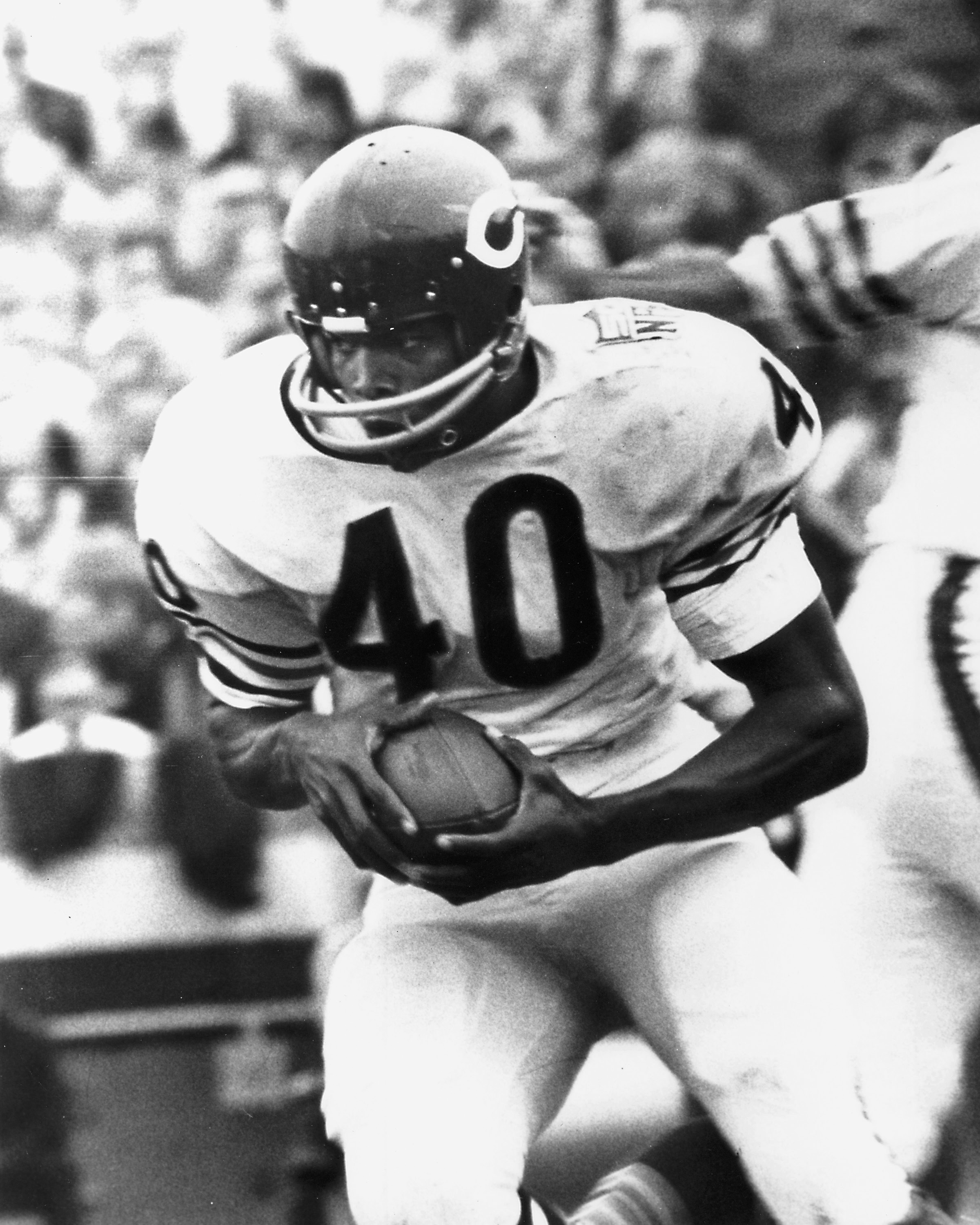
Although the T-formation is seldom used today, the most popular offenses are variations of the T. The quarterback still lines up behind the center for the snap. He hands off to one of the backs and also throws most of the passes. One halfback lines up a yard or two off the line of scrimmage and is called a flanker. Sometimes both halfbacks will become flankers. In one variation, a back goes in motion. This means that before the ball is snapped, the man in motion will move left or right. He cannot move forward. This maneuver forces the defense to shift and often leave a weak spot.
The remaining backs who are neither flankers nor in motion do most of the running and are thus called running backs. If one of the running backs is primarily a blocker, he may be called a blocking back. Another variation of the T-formation has only one running back. The blocking back moves to a flanker position to improve his blocking angle or to enable him to break down-field to receive a pass. Sometimes the back goes in motion from the flanker position. A back used in this way may be called an H-back. Every back who lines up behind the center is eligible to catch a pass, including the quarterback in certain circumstances. A pro-set formation has two running backs split apart and two wide receivers, one in the backfield and one on the line of scrimmage.
The defensive team
is divided into three units: the line, the linebackers, and the secondary.
The line
may have as many players as the defensive team chooses. But most teams use three, four, or five players. A three-man line consists of a middle guard, also called a nose guard or nose tackle, and two ends. A four-man line, called the front four, consists of two tackles and two ends. A five-man line consists of a middle guard, two tackles, and two ends. The defensive linemen use their size and strength against offensive blockers.
The linebackers
position themselves two or three yards behind the linemen. A team that uses a four-man line will normally have three linebackers. The player who lines up facing the center is the middle linebacker. The two other players, called outside linebackers, stand outside the defensive ends. Four linebackers are used with a three-man line, and two are used with a five-man line. In certain defensive formations, the linebackers will move up to the line of scrimmage with the linemen.
Linebackers, especially middle linebackers, make many tackles. They must combine strength with the ability to move quickly to wherever the ball carrier is running. They must also be good pass defenders.
The secondary
is made up of two cornerbacks and two safeties. They are often called defensive backs. Their chief task is to defend against the offensive team’s passing attacks. They also try to tackle ball carriers who have gotten by the linemen and linebackers. Defensive backs must be fast enough to cover speedy pass receivers, and they must be especially sure tacklers.
The cornerbacks stand 8 to 10 yards behind the line of scrimmage at the corners of the defensive formation. They defend against short passes thrown toward the sidelines. Safeties play 8 to 12 yards behind the line of scrimmage and defend against long passes. Sometimes, secondaries use double coverage, in which two defensive backs cover an especially dangerous receiver.
Many defensive teams favor zone coverage in the secondary, and others prefer man-to-man coverage. In zone coverage, each defensive back is responsible for a certain area. In man-to-man coverage, a defensive back is assigned to cover a particular receiver.
The coaches.
Every team has a coaching staff made up of a head coach and a number of assistant coaches. The head coach decides which players play which positions and, often, what plays are used during a game. Most assistant coaches work with particular players on the offensive and defensive teams. Some assistant coaches may perform other duties, such as scouting opposing teams for their strengths and weaknesses.
Between games, the coaches conduct practices to correct players’ mistakes and to oversee their physical conditioning. The coaches also prepare for the next game by developing a game plan. A game plan is a list of offensive plays and defensive formations that the coaches believe will work against the opponent. A few coaches discuss the game plan with the quarterback and then allow him to select his own plays during the game. However, most coaches prefer to choose the plays themselves. During a game, they send in their instructions for each play with a substitute player. They may also use hand signals from the sidelines, or sometimes transmit messages to a tiny radio receiver in the quarterback’s helmet.
How football is played
The playing time
in college and professional football games is 60 minutes. High school games last 48 minutes. A game is divided into halves. Each half, in turn, consists of two quarters. An intermission, called half-time, lasts about 20 minutes between halves. There are 1-minute or 2-minute rest periods after the first and third quarters. At the end of each quarter, teams change goals. 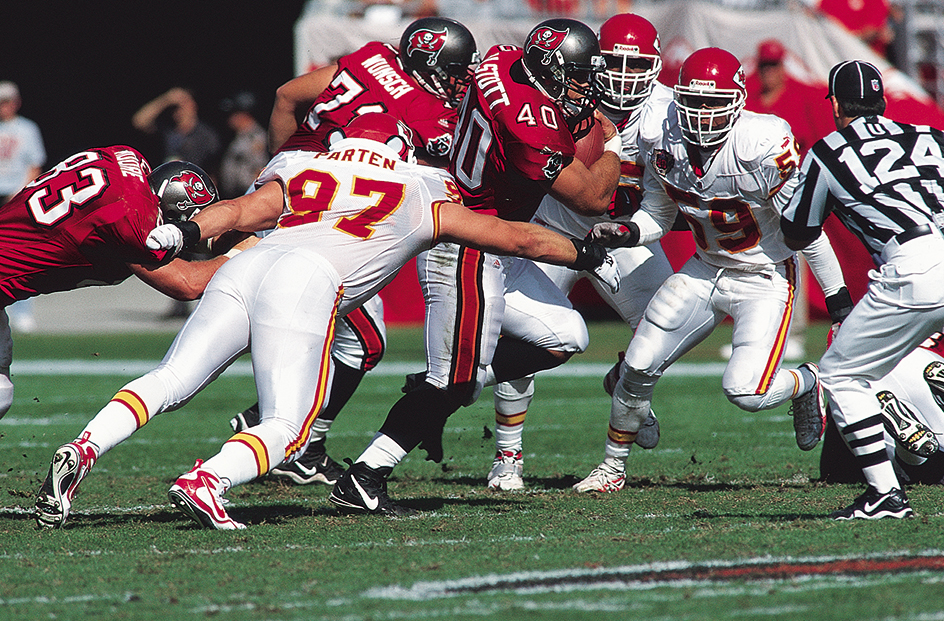
The official time clock is stopped only after an incomplete pass, if a player is injured, after a team scores, if a ball carrier goes out of bounds, if a player on either team or an official calls a time out before the ball is snapped, or after an official calls a penalty. Each team may call up to three time outs each half. Time outs last 90 seconds in high school and college games and 2 minutes in NFL games. In college games, the clock is also stopped briefly after each first down to move the first down markers. During the final 2 minutes of NFL games, the clock is stopped after some plays while the ball is placed in position for the next play.
The kickoff
starts each half of a game. A team also kicks off after it scores a touchdown or a field goal.
The team that kicks off to begin the game is decided by a coin toss at midfield. The team that wins the toss may make the kickoff, receive the kickoff, or select the goal it wishes to defend. The team that loses the toss gets the choice of kicking, receiving, or defending either goal when the second half begins. The team winning the coin toss may defer its choice to the second half. The other team then chooses.
The kickoff is made from the 40-yard line in high school games and from the 35-yard line in college and NFL games. Most kickers prop the ball on a tee to kick it.
The kicker’s teammates stand in a line across the field until the ball is kicked. Generally, the receiving team places two fast runners near its goal line. The runner nearest the ball catches it and runs it back toward the other team’s goal. The opposing players run to tackle him, and the runner’s teammates try to block them.
After a kickoff travels 10 yards, it becomes a free ball—that is, either team may recover it. Normally the kicker tries to kick the ball as far down the field as possible. Sometimes, he will kick it only a short distance to give his team a chance to recover the ball before the receiving team does. This maneuver is called an onside kick.
The ball is ruled dead if it is kicked beyond the end zone or if the kick returner catches it in the end zone and touches the ground with his knee. The officials then call a touchback and put the ball in play on the receiving team’s 20-yard line. The kick returner is ruled down if he goes out of bounds or if any part of his body except his feet or hands touches the ground. In the NFL, the kick returner must be downed by an opponent. If the returner slips and falls but is not touched by an opposing player, he may get up and advance the ball until he is tackled or goes out of bounds.
After the kick returner is downed, the officials place the ball at the point where the return ended. The offensive and defensive teams then come on the field.
Advancing the ball.
The offense has four plays, called downs, to advance the ball at least 10 yards by running or passing. If the team gains 10 yards, it gets a first down. If it fails to make a first down, it loses possession of the ball. Each time a team gets a first down, it receives another four downs to gain 10 yards.

In college games, when a player is tackled in bounds or does not get a first down, the offense has 40 seconds to put the ball in play after the referee has signaled to begin. If the player goes out of bounds or gets a first down, the offense has 25 seconds after the ball is spotted. In the NFL, the offense has 40 seconds in all cases.
Before a play begins, each team usually gathers in a huddle behind its side of the line of scrimmage. In the offensive huddle, the quarterback names his team’s next play, the formation to be used, and the number or color he will call out to signal the center to snap the ball. In the defensive huddle, a formation is called that the team hopes will stop the offensive play.
After the teams have huddled, they line up facing each other along the line of scrimmage. The center begins the play by snapping the ball to the quarterback. The quarterback then hands or pitches (tosses) the ball to a running back, runs with it himself, or throws a pass. The offense directs running plays around either of the ends, between an end and a tackle, between a tackle and a guard, or between a guard and the center.
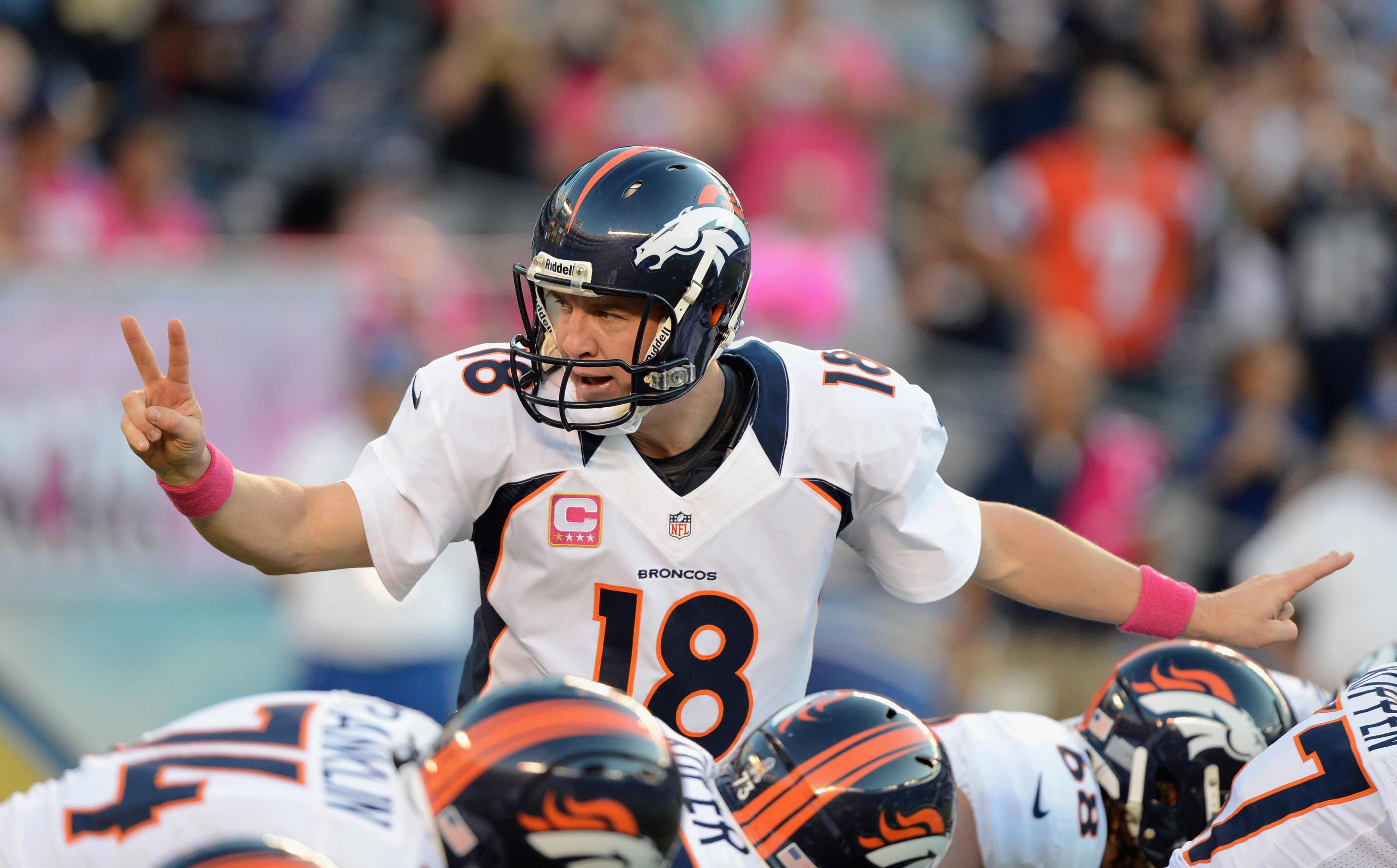
The defense may also gain possession of the ball by recovering a fumble. A fumble occurs if an offensive player drops the ball. Interceptions and fumbles are also called turnovers. A defensive player may run with a fumble if he catches the ball before it hits the ground or if he picks the ball off the ground while he is on his feet. In college games, if the player recovers the ball while he is on the ground, the ball is dead and his team gets the ball at that spot. In the NFL, a defensive player is allowed to get up and run with the ball after recovering it while on the ground.
If the offensive team does not make a first down in three plays, it usually punts the ball on fourth down. A punt gives possession of the ball to the other team. Any offensive player may punt. The kicker stands 10 to 12 yards behind the center, who snaps the ball to him for the punt. A long or well-aimed punt can force the opposing team to start its offense deep on its own side of the field. If, instead of punting, the offense tries to make a first down on fourth down and fails, the other team gets the ball where the play ends.
Scoring.
A team earns points by scoring a touchdown, a conversion, a field goal, or a safety.
Touchdown.
A touchdown earns 6 points. The offense scores nearly all touchdowns. It does so by running the ball or catching a pass over the opposing team’s goal line. Occasionally, the defense scores a touchdown through an interception or a fumble recovery or by recovering a blocked punt in the end zone. A touchdown can also be scored on a kickoff or punt return if the receiving team runs the kick over the opponent’s goal line.
Conversion.
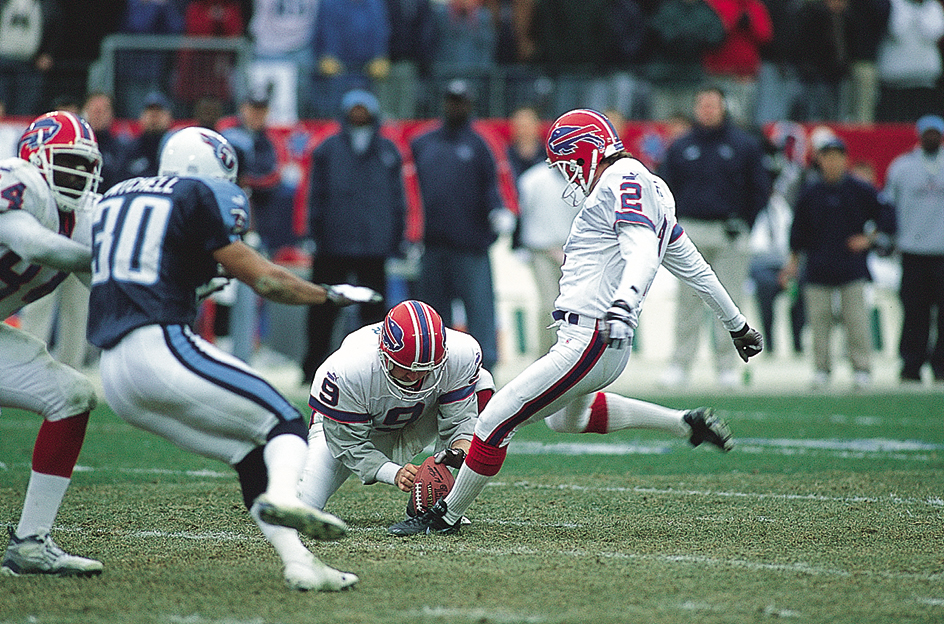
Field goal.
A field goal is worth 3 points. It is scored by place-kicking the ball over the crossbar and between the goal posts. The kick may be made from anywhere on the field. If the field goal is missed, the defensive team gets possession of the ball. In high school games, the ball is placed on the 20-yard line. In college games, the ball is returned to the line of scrimmage or to the 20-yard line if the line of scrimmage was inside the 20. In the NFL, the ball is placed where the kick was tried, usually about 7 yards behind the line of scrimmage.
Safety.
Only the defense can score a safety, which is worth 2 points. The defense earns a safety if it tackles the ball carrier in his own end zone, if the ball carrier steps out of the back or side of his end zone, or if a blocked punt goes out of the end zone.
The officials
supervise the football game and enforce the rules. Each official has particular duties, but any of the officials may call a rule violation.
The chief official is the referee, who has general charge of the game. He has the final word on all rulings. The referee stands behind the offensive backfield. The umpire is positioned behind the defensive line and watches for violations in the line. The head linesman stands at one end of the line of scrimmage. He marks the forward progress of the ball. He also supervises the sidelines crew, which keeps track of the downs and the yardage needed for a first down. The field judge stands behind the defensive secondary in the middle of the field. He watches for violations on punt returns and pass plays down-field. The back judge is positioned behind the defensive secondary near a sideline. His job is to spot violations between the defensive backs and the offensive pass receivers. The line judge stands opposite the head linesman and, like the umpire, watches for violations in the line. The line judge is also the official timekeeper. The NFL also uses a side judge. He stands opposite the back judge and on the same side of the field as the head linesman. The side judge has the same responsibilities as those of the back judge.
Violations and penalties
are called when players break the rules. An official signals a violation by throwing a cloth, called a flag, in the air. In most cases, a violation occurs during a play, and the officials allow the play to be completed. The referee then explains the violation to the captain of the team that was fouled. The captain has two choices. He may accept the penalty to be imposed on the team that made the foul. Or he may refuse the penalty and keep the completed play. If he accepts the penalty, it is enforced and the down is usually replayed. If he accepts the play, the penalty is disregarded. A team is penalized for a violation with a loss of yardage and, in some cases, also the loss of a down. Common violations include clipping, holding, offside, interference, roughing, and illegal procedure.
Clipping
is committed if an offensive player blocks a defensive player from behind, beyond the line of scrimmage. The penalty is 15 yards.
Holding
is called against an offensive player who uses his hands to block a defensive player. In high school and college games, a defensive player is penalized for holding if he uses his hands except to tackle a ball carrier. In the NFL, a defensive player may use his hands under certain conditions. The penalty is 10 yards for offensive holding and 5 yards for defensive holding. In the NFL, defensive holding includes a 5-yard penalty plus an automatic first down for the offense.
Offside
is called if any part of a player’s body is beyond the line of scrimmage when the ball is snapped. The penalty is 5 yards.
Interference
is ruled if the pass receiver or pass defender is blocked, tackled, or shoved while the ball is in the air. In defensive interference in the NFL, the offense gets the ball at the spot of the foul and receives a first down. In college football, the defense is penalized from the line of scrimmage and the offense receives a first down. In offensive interference, the offense is penalized 15 yards and loss of the down.
Roughing
is a foul committed against a kicker or passer. The defense may not tackle or bump a kicker while he is in the act of punting or place-kicking. The defense may tackle a passer only while he has the ball. The player may not be hit after he throws the pass. The penalty for roughing a kicker or passer is 15 yards and an automatic first down.
Illegal procedure
is called if the offense does not have seven players on the line of scrimmage or if an offensive player moves forward before the ball is snapped. It is also called if the offense or defense has more than 11 players on the field. The penalty is 5 yards.
Football competition
Most organized football games in the United States are played by high school, college, and professional teams. There are also programs for young players not organized by schools. These include “pee wee” programs of the Pop Warner league for children aged 5 to 16. The league is organized according to players’ ages. Games in the Pop Warner league follow almost the same rules used in high school and college games.
High school competition.
Thousands of U.S. high schools have football teams. The National Federation of State High School Associations oversees most high school athletic programs, including football. In addition, each state has an organization that sets rules and policies for high school sports teams. Most high school teams compete in classifications determined by school enrollment and general location. Nearly all states have a playoff schedule that ends with two teams competing for the state championship in their classification.
College competition.
Hundreds of colleges and universities in the United States sponsor football teams. Most of the schools belong to a conference. Officials of each conference set standards and rules for competition among the member teams. Each season, the teams in a conference play one another for the conference championship. Some teams, called independents, do not belong to a conference. They play other independents as well as conference teams.
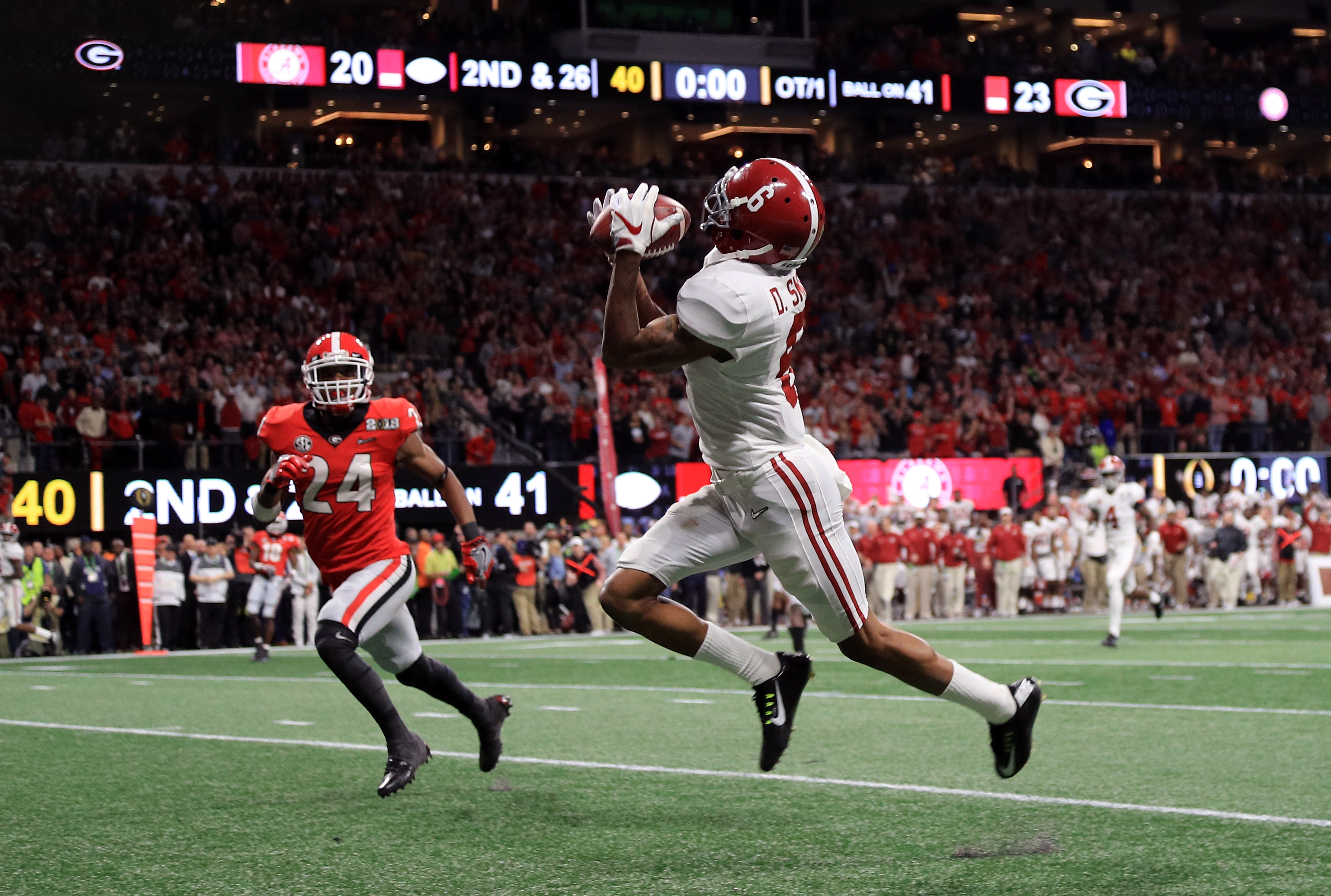
Conference and independent teams belong to the National Collegiate Athletic Association (NCAA) or the National Association of Intercollegiate Athletics (NAIA). These organizations set rules and supervise competition among member teams. Teams from two-year schools, called junior colleges or community colleges, also compete against one another. They are governed by the National Junior College Athletic Association.
Most college teams play 12 games during the regular season. After each season, some of the teams with the best records are invited to play in bowl games. Most college bowl games are played in late December or early January. After the end of the regular season, a special committee selects four teams to compete in a championship playoff. The two semi-final games and the championship game of the playoff rotate among six bowls. There are also postseason all-star games. Players who have ended their college careers may be invited to play in one or more all-star games.
Professional competition.
The National Football League has been in operation as a professional league since 1920. The NFL consists of 32 teams, each of which represents a city or region in the United States. The teams are divided into the American Football Conference and the National Football Conference. Each has four divisions.
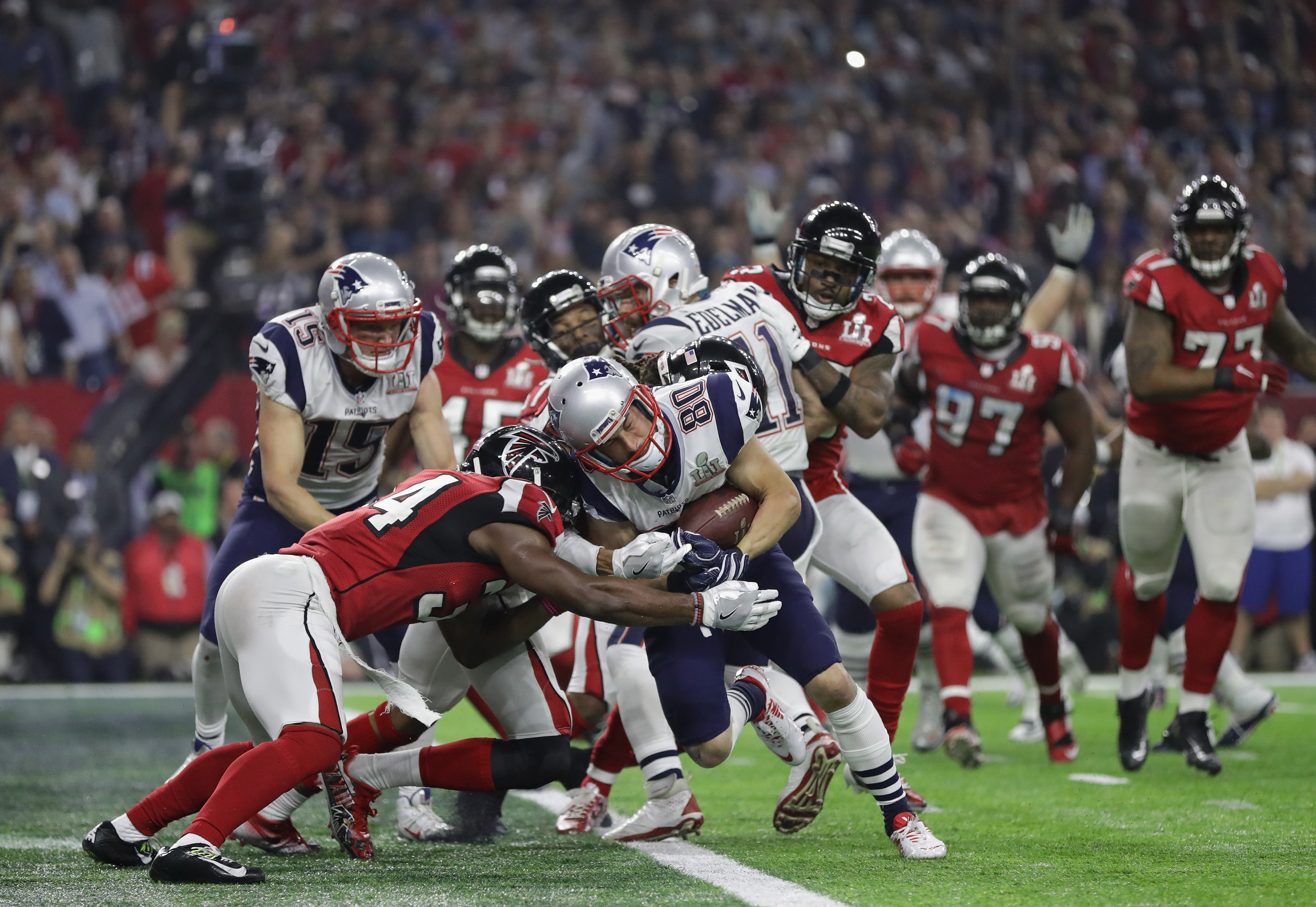
Teams in the NFL play a regular season schedule of 17 games. The division champions and the next three teams in each conference with the best won-lost records advance to the playoffs. A series of playoff games determines the two conference champions. These teams then play for the National Football League title in a game called the Super Bowl.
Each year, NFL teams obtain college players through a system known as a draft. Most of the players the teams choose are seniors who have completed their college playing careers. However, juniors and underclassmen who declare their eligibility for the draft may be selected. The first choice goes to the team that ended the preceding season with the worst record in the league, unless that team trades the draft choice. The Super Bowl winner picks last. No team may sign a player drafted by another team unless the player is released by the drafting team. If a college player is not drafted, he may sign with any professional team.
Canadian football
Although hockey ranks as the favorite team sport in Canada, football is gaining popularity. Football is played in Canada by high schools, colleges and universities, and the nine professional teams that make up the Canadian Football League (CFL). The playing field in the CFL is 130 yards long and 65 yards wide, and the goal posts are on the goal line.
Most Canadian football is played by 12-member teams. The positions resemble those in U.S. football. On offense, the 12th player lines up in the backfield or is used as an end. On defense, the 12th player serves as a linebacker or plays in the secondary. The offense has only three downs to make a first down. 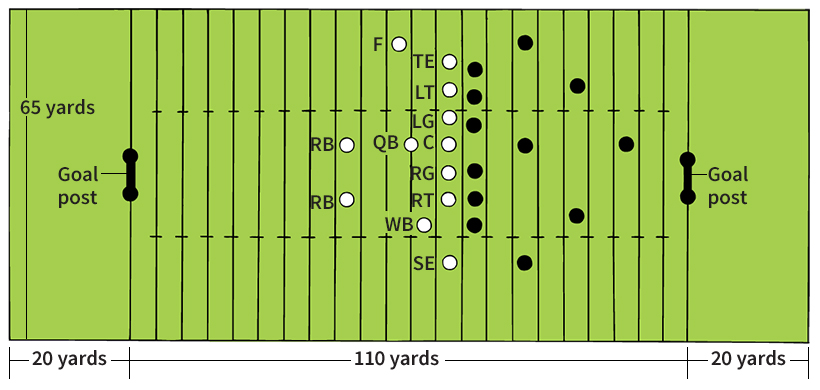
Scoring in Canadian football differs from that in U.S. football in only one way. The Canadian field has a dead-line 20 yards behind each goal line. On a kickoff, the receiving team must advance the ball out of the area between the dead-line and the goal line. If it fails, the kicking team scores 1 point, called a single, or rouge. The same rule applies to a punt.
Nearly all Canadian colleges and universities compete in four regional conferences. The champions of each conference meet in postseason playoffs. The team that wins the playoffs is the national collegiate champion and receives the Vanier Cup.
The CFL is divided into an East Division and a West Division. The division champions compete for the league title. The winning team receives the Grey Cup. For a table of cup winners, see Grey Cup.
The history of football
Beginnings.
Football began to develop during the mid-1800’s, when a game similar to soccer was played in the eastern United States. The object of the game was simply to kick a round ball across the other team’s goal line. The teams sometimes had 30 or more players. As the soccerlike game became popular, stricter rules were adopted and schools began to organize teams. The first college game was played on Nov. 6, 1869, in New Brunswick, New Jersey. In that game, Rutgers defeated the College of New Jersey (now Princeton University), 6-4.
The first game resembling present-day football was played in 1874. That year, a team from McGill University in Montreal, Canada, visited Harvard University. The Canadian team wanted to play the English game of rugby, which permitted running with the ball and tackling. Harvard preferred to play its soccerlike game, in which players advanced the ball mainly by kicking. The teams agreed to play two games, the first under Harvard rules and the second under McGill rules. Harvard liked McGill’s rugby game so much that it introduced the sport to other colleges. Running and tackling soon became as important as kicking in the U.S. game.
Shortly after colleges took up rugby-style football, they began to change and improve the game. The most influential figure in modernizing football was Walter Camp. Camp played for Yale University from 1876 to 1882. During the 1880’s, he led colleges to adopt rules that increased the game’s action and competition. Camp was largely responsible for establishing the system of downs and yards to gain and for introducing the center snap to the quarterback. He also helped set up the scoring system in which touchdowns, conversions, field goals, and safeties were worth different numbers of points. In 1889, he and sportswriter Caspar Whitney began the tradition of picking an annual all-American team to honor the best college players in the country.
During the 1880’s, football gained in popularity. More colleges played the sport, and many high schools formed teams. Numerous towns organized teams of players who were not in high school or college. Rivalries grew between teams from neighboring towns.
Changes in the game.
By 1900, football consisted mostly of running, blocking, and tackling. The blocking and tackling became increasingly violent. Many players suffered serious injuries. The uniforms provided little protection. Players did not even wear helmets. Many games were organized fights rather than athletic contests. In 1905, President Theodore Roosevelt urged changes in the rules to make the game safer.
In 1906, college coaches and faculty members tried to find ways to eliminate some of the violence in football. One new rule permitted a back to throw the ball forward to another back or to one of the ends. According to many historians, the first forward pass was thrown in 1906 by Wesleyan University in a game against Yale.
At first, teams ignored the forward pass. They did not consider it a logical way to advance the ball. Passing finally became popular in 1913 as a result of a game that year between Notre Dame and Army. The stronger, heavier Army team was favored to defeat the Notre Dame team. But Notre Dame quarterback Gus Dorais led his team to a 35-13 victory by throwing the ball several times to his end Knute Rockne. Rockne later became a famous head coach at Notre Dame. By the 1920’s, the forward pass had become a basic part of football and helped make the game more exciting. Meanwhile, most other basic rules had been adopted. In 1912, for example, a touchdown’s value was set at 6 points, and the number of downs was set at 4.
The rise of professional football.
On Nov. 12, 1892, William “Pudge” Heffelfinger was paid $500 to play football for the Allegheny Athletic Association in a game against the Pittsburgh Athletic Club. Sports historians mark this game as the start of professional football. In the early days of football, many college players played with their school teams on Saturdays and with professional teams on Sundays. They usually performed professionally under assumed names because of rules permitting only amateurs in college football.
Professional football had little organization until 1920. That year, the American Professional Football Association was founded. In 1922, the organization was renamed the National Football League (NFL).
Professional football began to win wide support in 1925. That year, Red Grange, a famous all-American halfback from the University of Illinois, signed to play with the Chicago Bears. He played in a series of games that drew over 350,000 fans.
In 1933, the NFL split into two divisions. Later that year, the Chicago Bears, Western Division champions, defeated the New York Giants, Eastern Division champions, for the first world professional football title. The league held its first draft in 1936.
In 1944, an eight-team league called the All-America Football Conference was formed. The league began competition in 1946. The All-America Football Conference and the NFL merged in 1950 into a 13-team league.
During the 1950’s, professional football began to gain great popularity throughout the United States. Under the leadership of Pete Rozelle, NFL commissioner from 1960 to 1989, the league added several teams and enormously increased its income from television.
In 1960, another professional league, the American Football League (AFL), was formed. The AFL competed with the NFL for fans and players. The 1966 NFL and AFL champions played in the first Super Bowl in January 1967. The Super Bowl became the most popular annual televised sports event in the United States. After years of rivalry, the two leagues merged in 1970 into one league. The league consisted of the American Football Conference and the National Football Conference.
New professional leagues.
A new professional league, the World Football League, played in 1974 and part of 1975 before financial losses put it out of business. Another professional league, the United States Football League (USFL), began play in 1983 but suspended play after the 1985 season. A new USFL competed in 2022 and 2023. This new USFL used the same name as the earlier league, but was not associated with it.
In 1987, the indoor Arena Football League was established. After canceling the 2009 season, the league resumed play in 2010. The league continued playing until 2019, when it went bankrupt and disbanded. Games were played on an indoor padded surface 50 yards long and 85 feet wide. Eight players were on the field for each team. In February 2023, the league announced that it was planning to return in 2024.
In 1991, competition began in the 10-team World League of American Football, an international professional league sponsored by the NFL. The league consisted of three European teams, one in Canada, and six in the United States. In 1998, the league was renamed NFL Europe and reorganized into a six-team league of European teams. The league’s name changed again in 2006 to NFL Europa. But in 2007, the NFL disbanded the league.
In 2018, the formation of a new professional football league was announced. The league, called the XFL, consisted of eight teams and had slightly different rules than the NFL has. The XFL began play in 2020. However, most of the league’s regular season was canceled because of the COVID-19 pandemic (worldwide epidemic). The league suspended its operations in April and declared bankruptcy shortly thereafter. A group of investors later purchased the XFL, and the league resumed play in 2023. In late 2023, the XFL and the USFL merged to form the United Football League (UFL). The UFL is scheduled to begin play in 2024.
Violence issues.
Excessive violence in games and the injuries the violence produces have become major issues in football, especially in the NFL in the early 2000’s. Numerous former NFL players have sued the NFL, claiming that the league had been aware for decades that concussions from playing football cause brain damage but concealed that information from players. In another violence matter, the NFL charged that members of the New Orleans Saints defense maintained a bounty program for three seasons starting in 2009 that paid cash rewards to players who inflicted injuries that forced opposing players to leave the game. The league suspended several New Orleans coaches and players for various periods and fined the team $500,000.
The NFL faced additional violence issues in 2014, this time involving highly publicized cases of domestic violence. Several players were charged with child abuse or physically assaulting their wives or girlfriends. The public and the media criticized league and team management for either reacting too slowly to the charges or issuing insufficient penalties. The NFL and team owners announced they would deal more forcefully with the violence issue, including demanding higher standards of conduct for players and increasing penalties for violations.
Franchise moves.
In January 2016, the NFL owners voted to allow the Saint Louis Rams football franchise to move to Los Angeles, beginning with the 2016-2017 season. In 2020, the Rams began playing in Inglewood, southwest of downtown Los Angeles. The Los Angeles Chargers, who moved from San Diego to Los Angeles for the 2017-2018 season, began sharing the Inglewood stadium with the Rams in 2020. In March 2017, the NFL voted to allow the Oakland Raiders to move to Las Vegas, Nevada. The team, now called the Las Vegas Raiders, began playing in Las Vegas in 2020.
